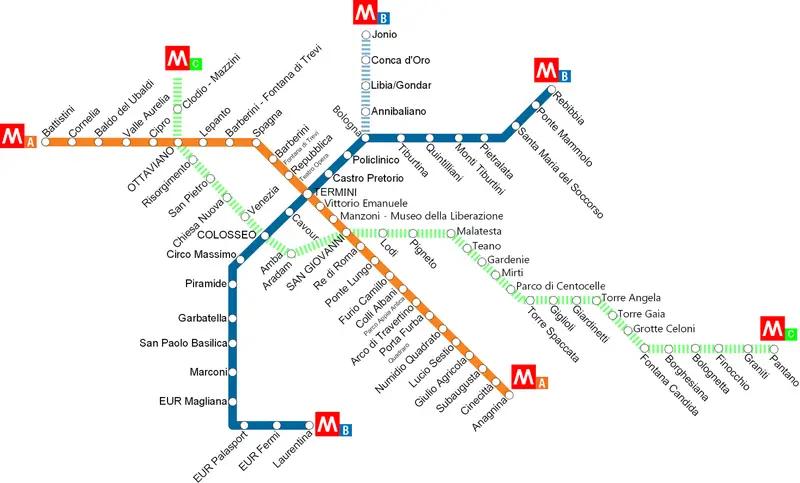More information about the Rome Metro
The metro of the city of Rome is the oldest in Italy and was created in 1955. The historic city is dotted with archaeological remains that are discovered with each opening of new tunnels. Currently, there are three metro lines, with the latest still under construction. ATAC is the public transport service organization in Rome (buses, trams, trolleybuses, metro trains). Trains run on average every 4 minutes.
To see the tourist sites closest to your metro train, feel free to get the "Guide du Routard" guidebook.
The metro is open from 5:30 am to 11:30 pm and until 1:30 am on weekends. The ticket price varies depending on the validity period you want. You can buy your tickets almost anywhere (automatic vending machines in the metro, tobacco shops, or even via SMS). There are many packages that I detail for you.
- Single trip at €1.50
- 24h ticket at €7
- 48h ticket at €12.50
- 72h ticket at €18
- Weekly pass (7 days) at €24
Line A
Line A consists of 27 stations over more than 18 km of tracks. It has been in existence since 1980. It runs from Battistini to Anagnina. To reach the Trevi Fountain, you will need to stop at the Barberini - Fontana di Trevi station. The Vatican is accessible by stopping at the Ottaviano-S. Pietro station.
List of stops on Line A of the metro
- Battistini
- Cornelia
- Baldo degli Ubaldi
- Valle Aurelia
- Cipro Musei Vaticani
- Ottaviano
- Lepanto
- Flaminio
- Spagna
- Barberini
- Repubblica
- Termini
- Vittorio Emanuele
- Manzoni
- San Giovanni
- Re di Roma
- Ponte Lungo
- Furio Camillo
- Colli Albani
- Arco di Travertino
- Porta Furba
- Numidio Quadrato
- Lucio Sestio
- Giulio Agricola
- Subaugusta
- Cinecittà
- Anagnina
Line B
Line B consists of 26 stations over more than 23 km of tracks. It has been in existence since 1955 and is the most used line in the Rome metro. Please note, Line B forks after the Bologna stop, it will then take you towards Jonio or towards Rebibbia. To access the Colosseum, you will need to exit at the Colosseo station.
List of Line B stations
- Laurentina
- EUR Fermi
- EUR Palasport
- EUR Magliana
- Marconi
- Basilica San Paolo
- Garbatella
- Pyramide
- Circo Massimo
- Colosseo
- Cavour
- Termini
- Castro Pretorio
- Polliclinico
- Bologna
- Direction Rebibbia
- Tiburtina FS
- Quintiliani
- Tiburtini Monti
- Pietralata
- Santa Maria del Soccorso
- Mammolo Ponte
- Rebibbia
- Direction Ionio
- Sant'Agnese/Annibaliano
- Libia
- Conca d'Oro
- Ionio
Line C
Line C consists of 22 stations over more than 19 km of tracks. Line C is the newest (2014). It should reach 30 stations in the end. This third metro line serves the East of Rome.
Liste des stations de la ligneC
- Monte Compatri - Pantano
- Graniti
- Finocchio
- Bolognetta
- Borghesiana
- Due Leoni - Fontana Candida
- Grotte Celoni
- Torre Gaia
- Torre Angela
- Torrenova
- Giardinetti
- Torre Maura
- Torre Spaccata
- Alessandrino
- Parco di Centocelle
- Mirti
- Gardenie
- Teano
- Malatesta
- Pigneto
- Lodi
- San Giovanni
- Amba Aradam - Ipponio
- Fori Imperiali/Colosseo
Easily travel by subway to Rome
The subway, short for "metropolitan railway," is a form of urban public transportation that allows you to travel through different metropolitan areas around the world without driving. No more endless traffic jams during rush hour. Taking public transportation or taking the subway has become very easy today. La carte de métro est téléchargeable ou accessible en ligne. The subway ticket can be purchased at the counter or with your phone. The price of tickets is more affordable than a taxi and more environmentally friendly.
